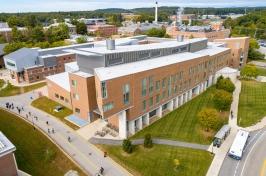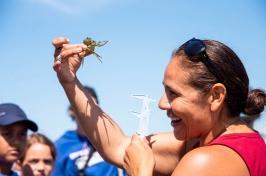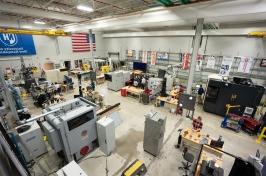Want to learn more about UNH's dairy research?
Join NH Agricultural Experiment Station staff and scientists at UNH's Fairchild Dairy Teaching and Research Center during the 11th Annual Durham Farm Day, held Saturday, August 17.
This family friendly event offers an opportunity explore Fairchild Dairy, learn more about the studies that take place, and enjoy free milk (while supplies last) from event partner Granite State Dairy Promotion. A tour of the Fairchild Dairy Teaching and Research Center will begin at 2 p.m.
For a complete schedule of events — including Farm Day activities taking place at Kingman Research Farm and UNH's teaching high tunnels — read our blog post.
The Northeast’s dairy industry has changed dramatically over the past 50 years, and it will continue transforming and evolving for the next 50 years, as current and future dairy farmers explore new technologies and management practices to make their operations more sustainable and capable of supporting regional food systems. However, innovative research, led by scientists right here at the New Hampshire Agricultural Experiment Station (NHAES), will play a key role in supporting and advancing that change, offering solutions to everything from herd health and nutrition, disease management and operational costs – all with the goal of making dairy farming more efficient, effective and sustainable.
Healthier Calves, Lower Costs
Peter Erickson, Professor of Dairy Management
Healthy calves and cost-effective feed are two key components to a successful and sustainable dairy, as well as a research focus of Peter Erickson, Station scientist and a professor of dairy management. For calves, Erickson’s work aims to strengthen the animal’s immune system through feed additives that may prevent calves' susceptibility to a debilitating and potentially life-threatening disease called coccidiosis, as well as assessing adult cows’ milk production in response to feed supplements made from lobster and crab shells – a seafood byproduct that could be used to increase milk quality.

Calves that can mature and enter the milking herd are critical for farms to continue their operations. One major challenge to this transition, however, is coccidiosis, a debilitating disease caused by parasites that affect calves and can lead to significant financial losses for dairy farmers due to decreased productivity and increased veterinary costs. The disease can cause severe diarrhea, dehydration, and malnutrition, resulting in high mortality rates among calves especially. Erickson is exploring using sodium butyrate, a feed additive with antimicrobial properties, as a potential solution. Additionally, he is investigating the use of lobster and crab meal as a cost-effective feed additive to reduce expenses for dairy producers. Regionally sourced from the waste from canneries, ground and pasteurized crab and lobster meal could serve as a replacement for expensive grain feed supplied from other parts of the country. The shellfish meal could help reduce cases of the calcium deficiency condition known as hypocalcemia.
“Finding effective treatments for coccidiosis is important to creating a more sustainable dairy industry,” said Erickson. “It’s a disease that accounts for $400-$700 million in annual losses for the global cattle and bison industry and, in the U.S., has an estimated mortality rate of 20% for cattle treated for the disease.”
Methane-reducing Dairy Feeds
Andre Brito, Professor of Organic Dairy Management
While the dairy sector contributes to global methane emissions, its overall greenhouse gas footprint is relatively small compared to other industries like transportation and energy. Methane, however, is a potent greenhouse gas, and enteric fermentation – the process where microbes in the rumen (i.e., largest stomach compartment) of cows break down carbohydrates and release gas, including methane – is a major source of methane. The dairy industry accounts for about 10 percent of total methane emissions in the United States according to the EPA, making it crucial to address these emissions to help mitigate climate change.

Station scientist and professor of organic dairy management Andre Brito explores innovative dietary strategies to reduce methane emissions in organic dairy cows. One focus is on using essential oils, Brito's studies have shown that integrating essential oils into the diets of grazing dairy cows decreases methane emissions while improving milk production and composition. Additionally, essential oils have been shown to aid the cows' digestive processes, leading to better feed efficiency and increased milk fat and yield. Brito is also investigating the use of the red seaweed (Asparagopsis taxiformis) to mitigate enteric methane emissions. This seaweed has been shown to reduce methane emissions from cattle by over 80 percent. The more widely available brown seaweed Ascophyllum nodosum was shown to marginally decrease methane emissions and may be more suitable to be used as source of minerals or to improve animal health.
“Research to date into the use of essential oils has shown that their use had both a positive impact on milk production, increasing it by more than 6%, and that it decreased methane intensity (g of methane/kg of energy-correct milk by 6%,” said Brito. “With the use of this feed, we also found that milk fat increased and milk somatic cell count decreased – which serves as an indicator of milk quality.”
Brito further stated that “red seaweeds and strategies to extract anti-methanogenic seaweed bioactive compounds area active research areas in our lab to decrease methane emissions in dairy cattle systems.”
Optimizing Dairy Health & Productivity, Through Technology
Claira Seely, Assistant Professor of Precision Dairy Management
Precision dairy farming leverages advanced technologies to more frequently monitor and manage more detailed aspects of individual cows’ health, behavior and productivity, helping dairy farmers detect diseases early, improve cow comfort, and optimize production processes. Claira Seely, a precision dairy management specialist at UNH, researches how integrating these technologies into dairy herd management could improve farm efficiency and animal health.

Seely’s current work primarily targets cows in the early lactation period, a time when animals are most susceptible to health issues without easily discernable symptoms but can affect productivity and wellbeing. By using devices such as ear tags, collar tags and bolus pills—nondigestible pills that remain in the rumen of the cows—Seely can monitor cow health indicators like rumination patterns, activity levels, and gut health. These data could allow farmers to identify and address health issues promptly, reducing the risk of disease outbreaks and improving overall herd health.
“A goal of my research is to further understand the biology of early lactation cows, and then supplement that research with opportunities for smaller farm operations – like the majority of farms in New England – that don’t have capacity to milk thousands of cows at a time,” said Seely. “But by using these technologies, it helps eliminate the labor burden and allows these smaller operations to optimize their efficiency so they can thrive in a very different dairy market than we had 75 years ago.”
Enhancing Dairy Reproductive Health
Paul Tsang, Professor in the department of Molecular, Cellular and Biomedical Sciences
Infertility in dairy cows can be an issue that leads to substantial economic losses for farmers. Reproductive problems in dairy cows can result in decreased milk production and increased rates of removing cows from the herd, costing the dairy industry between $1–$2 billion annually. Station scientist Paul Tsang, a reproductive biologist at UNH, focuses on addressing these reproductive challenges by studying the corpus luteum—a gland formed in the ovary during a cow’s estrous cycle, and is critical to producing a hormone that's essential for maintaining pregnancy in dairy cows called progesterone.

Tsang’s research investigates factors that can affect the corpus luteum’s ability to produce sufficient progesterone. One aspect of his work examines how a newly built blood vessel network within the corpus luteum following ovulation supports the gland’s function and how various proteins and minerals help build and maintain this vascular network.
“Optimal development and function of the corpus luteum are vital for successful pregnancies in dairy cows,” explained Tsang. “By focusing on the cellular and molecular mechanisms that underpin fertility, this research aims to provide strategies and practical solutions that can improve the efficiency of this gland, thereby enhancing fertility rates and reducing embryonic loss.”
Optimizing Dairy Nutrition with Amino Acids
Nancy Whitehouse, Research Assistant Professor in the department of Agriculture, Nutrition, and Food Systems
Optimizing dairy cow nutritional management can boost milk production, as well as reduce the concentration of nitrogen in manure. When manure is spread on agricultural fields as a form of fertilizer, reduced nitrogen content can lower the risks of this nutrient entering nearby waterways and contributing to algal blooms. Nancy Whitehouse, a research scientist in dairy nutrition at UNH, is testing whether including rumen-protected amino acids in dairy cow diets can reduce nitrogen concentrations. Rumen-protected amino acids are designed to not break down in the cow’s rumen, but rather pass through this stomach area to the small intestine, where they can be absorbed more effectively and contribute to greater milk production and overall cow health.

Whitehouse's research demonstrates that by feeding cows specific amino acids—such as lysine and methionine—farmers can lower nitrogen concentrations in manure while maintaining milk production levels and lowering a cow diet’s overall protein content, which can often be a costly component of feed mixes. Whitehouse’s findings indicate that target amino acid supplementations can provide operational cost savings and reduce adverse environmental risks from dairy farm waste products.
“When lactating dairy cows are fed diets balanced for amino acids, especially lysine and methionine, the amount of protein fed to the cows can be decreased, therefore decreasing the amount of nitrogen being excreted into the environment,” said Whitehouse. “One way to meet the amino acid needs is to feed rumen protected amino acids, but determining how much of the protected amino acid is used by the cow is also very important and that is the work be conducted at UNH.”
This material is based on work supported by the NH Agricultural Experiment Station through joint funding from the USDA National Institute of Food and Agriculture (under Hatch award numbers 7005446, 7005568, 7005829) and the state of New Hampshire.
-
Written By:
Nicholas Gosling '06 | COLSA/NH Agricultural Experiment Station | nicholas.gosling@999lsm.net


























































